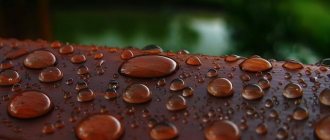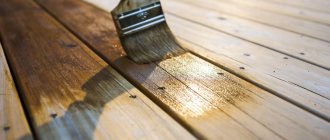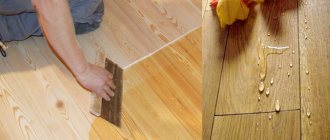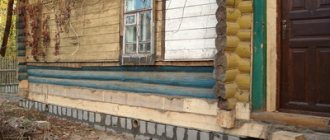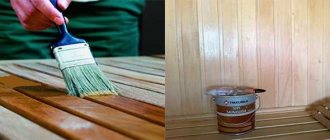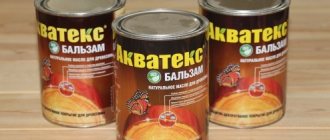Why is wood protection necessary?
The popularity of wood as an environmentally friendly material used in a variety of fields attracts both large manufacturers and ordinary users.
But wood has one feature that is worth considering. It is weakly resistant to moisture and decay, therefore it is subjected to special treatment. Before you start working with this natural material, you need to find out why wood needs protective manipulation by humans.
- Wood is a material that does not tolerate contact with moisture well. Most rocks begin to quickly become wet and deteriorate because of this, soon undergoing the process of rotting.
- Often wooden boards suffer from sudden temperature changes. They may begin to warp and become deformed.
- Wood can be seriously damaged by attacks from various wood parasites - beetles. They devour natural material, which is why its quality quickly decreases.
- Wood is also susceptible to fungal growths. The same mold, which often forms in conditions of high humidity, greatly spoils the quality and condition of the environmentally friendly material.
- The most dangerous thing for wood is contact with fire. The material not only ignites very easily, but also actively supports the flame.
To prevent all of the above factors from spoiling or completely destroying the natural material, specialized products are used that reliably protect the wood. After the treatment procedure, its performance characteristics and resistance to negative external influences increase sharply. The service life of wood increases noticeably, as does the service life of structures made from it.
What Causes Wood Rotting
Mold on wood
Rotting is caused by wood-destroying fungi; this damaging factor represents the main danger for construction wood. Microorganisms destroy the cellular structure; each type of fungus affects the wood structure differently:
- White rot. The fungus transforms the wood structure to the state of rot, in the initial phase it appears in the form of characteristic white fibers,
- Brown rot. The fungus destroys wood cellulose, develops rapidly, the wood darkens, loses strength and collapses, damage to load-bearing structures by this microorganism poses a danger to the entire structure,
- Soft rot. The rotting process is formed upon contact with soil, the wood structure is loosened, saturated with moisture, mucus is formed, and the material loses strength.
Most often, buildings are affected by a fungus that forms white rot, it is called white house fungus (Coriolus sinuosus). This species has adapted to breed not only in wooden buildings; traces of its activity can be found in the basements of brick buildings and structures. Visible white fibers are mycelium, which compacts and turns into a film, the affected area turns into dust.
White house mushroom (Coriolus sinuosus)
Fungal spores are found everywhere, they are easily carried by the wind; spore carriers can be birds, rodents and insects. Wood-decaying fungi can enter nutrient soil during wood harvesting, sawing and transportation. When favorable conditions are created, a mycelium is formed, the reproduction process occurs rapidly, the mycelium forms millions of spores per day. Rotting is promoted by a comfortable temperature - from 5 to 30 degrees, and high humidity of the wood pulp - more than 22%. Most often, rot affects the mortgage and lower crowns; the need to protect these elements is most urgent
Processing options
Protection of wood from fungus is carried out using a number of pre-conducted preventive measures. Choose one option or another based on the budget and operating conditions of the structure.
In construction stores there are different versions of such products available - both in the form of a solution and in the form of a paste. Protection should be applied not only to the wooden surface, but also to places in contact with the ground. The depth of impregnation is about one and a half meters. A solution of potassium dichromate (5%) or sulfuric acid (5%) is best suited. Novotex, Pinotex, Biokron and Biosept are antiseptics that are completely ready for use.
Only certain groups of antiseptics and impregnations are suitable for treating wood in the ground. Make sure that the product is moisture resistant, since underground the material is more susceptible to salt and moisture. It is necessary to cover with this preparation all surfaces of the structure that are exposed to precipitation.
Users often search for:
- Impregnations for wood
- How to paint a gazebo
- Wood protection for outdoor use
There are artificial and natural drying. The first option is carried out using petrolatum or storing wood in special chambers with elevated temperatures. The process occurs quickly: the time varies from one hour to several days, and the fungus dies under such conditions.
Natural drying is a more suitable option for doing it yourself. The wood is left under a canopy in the open air or stored in a well-ventilated area. The process takes a lot of time: from one week to several months, but this method does not require large material costs and guarantees reliable protection of the material.
A high foundation ensures a long service life of a wooden structure
How to prepare the surface for processing?
Before antiseptic treatment, it is necessary to prepare the wood for application of the composition. This is done in several stages:
- Surface cleaning. First you need to remove all dirt or formations that have appeared during operation.
- Grinding. All roughness and surface irregularities are removed by grinding. This way the solution will better penetrate the wood texture.
- Degreasing. Helps completely remove grease and dirt accumulated on the surface. The surface is wiped with white spirit applied to a lint-free cloth.
This method of preliminary preparation is suitable both for processing with ready-made solutions and for those prepared independently. After this, you can begin applying the antiseptic.
How does protection against moisture and rot work for wood?
It was already mentioned above that one of the reasons for the development of rot is high humidity. In some cases this is a consequence of precipitation, and in others it is a natural condition for a particular area (for example, coastal areas). In any case, the number one task to prevent rot is to protect the wood from external moisture. How to treat wood against rotting and moisture? To do this, you can purchase special preparations sold in hardware stores.
They are applied to the surface and make it water-repellent. Water falling on the walls of the house will immediately roll down, rather than remaining on the wood, gradually being absorbed and leading to the development of rot.
Some of them are applied comprehensively and have higher efficiency and durability. Others are applied one at a time - this is cheaper and takes less time. But their service life is noticeably shorter.
How to choose a moisture meter for wood
To choose a moisture meter for your own needs, you need to carefully study the market and the characteristics of the devices presented on it. The main parameter of each device is the range in which humidity can be measured.
Most often, high-quality devices with minimal error have a small measurement range. Conversely, if a device is capable of detecting humidity levels between 0 and 100%, the results will likely be seriously inaccurate.
This rule does not always work: some devices on the market can actually measure humidity in a wide range with almost no error, but they are quite expensive.
In addition to range and humidity, other characteristics to consider when choosing a moisture meter include:
- Purpose. Moisture meters can be designed to test a specific type of wood material. Some are for ready-made building materials, others are for sawdust, etc.
- Nature of use. The more often the device is used, the higher the requirements for its reliability and durability should be.
- Size and weight. If you plan to measure humidity frequently, it is better to give preference to a lightweight and compact device.
Additionally, do not forget about the cost of the device. The cheapest models rarely show high accuracy, so the savings can be very disappointing in the long run.
No. 4. Products for protecting wood from moisture
An increased level of humidity is the main enemy of wood, as it not only impairs performance, but also causes the appearance of mold and mildew. Treatment aimed at protecting against moisture begins with wood harvesting, and proper drying is of great importance. Even well-dried material will begin to absorb moisture over time, but in this parameter, different types of wood differ greatly. Larch, ash, pine, oak are more resistant to moisture, spruce, fir and beech are moderately resistant, and maple, birch and hornbeam are the most vulnerable. A number of tropical trees (kumaru, cousia, ipe, sisal) are practically not afraid of moisture and require only minimal protection.
The most important indicator of wood is intracellular moisture. For construction, you can use a material with a moisture content of 5-20%, and wood with a moisture content of 9-15% is suitable for truss structures and interior decoration, and 12-18% for exterior cladding.
To reduce the ability of wood to absorb moisture from the environment, i.e. To reduce its hygroscopicity, varnishes, oil impregnations and pastes are used, which are divided into two groups:
- the compositions that form a film on the surface are not durable enough, so the treatment will have to be repeated quite often;
- penetrating compounds are more durable and are able to penetrate the pores of wood; they are used to treat fences, window frames, house walls, and garden furniture.
As a rule, water repellents do not change the color of wood, and their effect is that drops of water simply roll off the surface without penetrating into the structure. A number of such products also have a frost-resistant effect.
Why does rot appear?
A common reason that triggers the rotting process is a fungus, the activity of which destroys the structure of the tree. If spores land on wood, it becomes infected and then damaged. The house mushroom is considered to be the most dangerous, since it affects even a tree protected from atmospheric influences.
The following signs of infection are identified:
- change in the natural color of the tree cover;
- the appearance of cracks;
- decrease in strength level;
- destruction of the structure.
Photo: floorboards frequently exposed to moisture
Wood exposed to:
- exposure to moisture;
- freezing and defrosting;
- influence of sunlight and wind.
The process begins on the outer layers, as well as in places where the tree comes into contact with the soil, and then develops very quickly. Window frames and the lower part of wooden houses are especially susceptible to damage.
The following conditions contribute to the appearance of mold:
- High air humidity (75-100%).
- The level of moisture content in the material (from 15%).
- Large temperature changes.
How to treat wood with anti-rot impregnations?
It is best to apply water-repellent wood impregnation in dry and warm weather. Before applying the anti-moisture and rotting agent, the surfaces to be treated must be thoroughly cleaned, since contamination prevents normal adhesion and full penetration of the composition into the structure of the material.
To obtain the best effect, it is important to follow the proportions recommended by the manufacturer (if the product requires dilution).
When applying antiseptic compounds it is recommended:
- Apply water-based and other low-viscosity glazes with a spray gun, and thicker ones with a brush or roller.
- Take into account the drying time of the selected impregnation - it depends on the type of product.
- For internal use, choose environmentally friendly compounds that are absolutely safe for people and pets.
- Apply as many layers as recommended by the manufacturer.
- Repeat the treatment at the frequency specified in the instructions - weak saline solutions are applied annually, and heavy resinous solutions last for several years.
- Use the purchased azure strictly for its intended purpose.
- Familiarize yourself with the rules for using antiseptics and strictly follow them.
Recommendations for the selection and use of wood impregnations
Impregnation should provide reliable protection of wood from rotting, fungal infections and biological destruction, but at the same time be absolutely harmless to people, animals and the environment. These are the tools it offers. Impregnations from our catalog:
- have a natural plant composition, so they can be used for interior woodwork without the slightest risk;
- provide excellent results for a long period of time;
- easy to apply;
- penetrate deeply into the wood structure;
- form a reliable water-repellent barrier;
- improve the performance characteristics of the material and protect it from the negative influences of the external environment.
Types of wood protection products
When choosing liquids to protect wood from moisture and rotting, consumers pay attention to its high efficiency. But, besides this, the substance must not be harmful to human health.
Most often, solutions that affect the durability of wood and can protect it from negative factors are quite dangerous.
It is absolutely necessary to ignore compounds containing tin and zinc compounds. These are the most toxic chemicals. Let's take a closer look at how to treat wood to protect it.
Decorative impregnation
Protecting wood from rot and water is the main task of moisture-resistant impregnation. The material processed with this composition is used to build baths, fences, basements, gazebos, etc. They are used both individually and in combination with bioprimers. The last substance must be treated with the boards before painting.
The essence of impregnation lies in its deep penetration into the structure of the wood and in this way clogging its pores. When treating wood with a solution, the penetration of moisture into the wood structure is limited. But besides this, impregnation colors wooden products and in this way gives them a noble appearance.
Oil based product
To prevent rotting, covering the boards with an oil-based product is necessary when using them externally. Protection of the board from rotting is ensured by the film formed after applying the product to the surface. Moreover, the resulting film on wood soaked in the solution does not allow water to be absorbed, and, therefore, prevents the fungus from penetrating into the wood structure.
The disadvantage of this product is the fact that a film forms on the surface, and it is not capable of protecting the tree from the effects of the fungus that already lives inside. The liquid composition of the impregnation is almost non-toxic, so it is used to cover wooden elements in houses where people live.
Water-based impregnation
Also, to protect wood from moisture, impregnation is used, which is well diluted in water. It is absolutely safe, there is no pungent odor when working with it, and it dries quickly. Water-soluble impregnations are used to prevent wood rotting and fungal penetration. Despite this, this composition is not recommended for use in rooms with high humidity. For example, when building a bathhouse, sauna or cellar.
The components of such solutions are boric acid, zinc chloride and sodium fluoride. They are better suited for wood, which is used in making furniture, making door openings, window slopes or frames.
Volatile based product
You can treat wood against rotting using means that have an easily volatile substance. The production of compositions is based on the addition of a certain substance to the coloring compositions, such as a solvent. Products of this type are not able to penetrate deeply into the structure of the wood, but at the same time they create a film whose strength is quite high.
Due to its volatility, the composition is best used for outdoor work, but it can also be used for interior wood processing indoors. The disadvantages of volatile agents include the long drying time of impregnating materials.
Arguments for the need to protect material
Before treating wood to prevent it from rotting, you need to know the nuances that make the material illiquid. The main cause of rot is a fungus that tirelessly destroys wood. House fungus is considered the most insidious. It can destroy even treated surfaces.
To recognize the appearance of fungus, you need to pay attention to the following factors:
- softening the material;
- formation of microcracks;
- change in natural color;
- destruction of the original structure.
Excellent conditions for the emergence and spread of harmful fungus are:
- climatic conditions (freezing, constant exposure to moisture, precipitation, direct sunlight);
- direct contact with the ground.
With proper treatment of wood against rotting and moisture, its service life can be extended to three decades. Although, depending on the degree of influence of negative factors, this period can change both positively and negatively. You can protect a tree by various means. The most common is impregnation for wood against moisture and rot.
Antiseptics are produced based on chemical components. Their variety is great in the construction market. Each product has different properties, so you need to be savvy and choose the right ones for wood processing.
No. 8. Sequence of application of protective agents
To ensure maximum safety of the wood, it is treated with protective agents in the following sequence:
- antiseptics at the stage of procurement and transportation, as well as after the construction of the structure, furniture, organization of finishing;
- treatment with fire retardants if necessary;
- treatment with moisture-repellent impregnations, which will also prevent the leaching of fire retardant and antiseptic;
- applying paints and varnishes with ultraviolet protection;
- sealing joints and seams using acrylic sealant is an important process that prevents moisture from penetrating into the wood.
How to apply a protective coating to wood
Applying antiseptics, varnishes and paints is not difficult. However, carrying out such work requires compliance with certain rules.
- Before handling, wear gloves, a protective mask and goggles.
- Clean the surface to be painted from dirt, grease and old paint with a scraper.
- Clean the board or beam with an old brush or sandpaper.
- Wash the surface with water and detergent.
- Wait until the wood is completely dry.
- Read the instructions for instructions on how to apply the product.
- Start processing wooden structures from the ends, cuts, and damaged areas.
- If it is necessary to apply several layers of coating, you should pause 2-3 hours between applying each layer.
Recommendations for application
Before protecting wood from moisture and rotting outdoors, it is important to study the recommendations for applying protective compounds. Compliance with the rules below will significantly improve the results of the work done:
If the wood is re-treated, the old layer should be carefully removed before applying the composition.
Depending on the condition of the surface layer of the wood, you can use a solvent, scraper or sandpaper. If work is carried out outdoors, it is important to monitor the temperature. The optimal range is from + 18 to + 25 degrees. If it is necessary to apply an additional layer of protective composition, this should be done no earlier than 3 to 5 hours after the first stage of work. It is recommended to apply a second layer of the composition to cracks and cuts, if any. Before treating wood from rotting and moisture, you need to thoroughly dry the material, preferably in the open air.
Before carrying out work, it is important to follow safety rules, namely, put on a respirator and gloves. Contact with skin and inhalation of vapors of protective compounds can cause serious harm to health.
Before work, be sure to wear gloves and a respiratorSource coffeesummit.org
Comparison of brands: which manufacturer to choose?
There are a large number of antiseptic protective agents on the market, and choosing among manufacturers can be very difficult. Funds can be divided into 3 categories:
- Budget ones are “Senezh”, “Aquatex”;
- Middle class – “Tikkurila”, “Belinka”;
- Professional – “Dulux”, “Teknos”, “Woodworks” and others.
According to the rating, they are placed this way: the more expensive the product, the higher quality it will be and will last longer.
There are a large number of antiseptic protective agents on the market, and choosing among manufacturers can be very difficult.
An antiseptic for wood is a mandatory element of the coating so that it lasts longer and biological formations harmful to health do not appear on it. You need to choose a product based on the stage of work, budget, and operating conditions. Having made the right choice, you can be confident in the safety of the surface.
No. 1. From what and in what cases should wood be protected?
Wood preservatives are aimed against various negative influences, and the choice depends on the conditions under which the material will be used. The main enemies of wood are:
- moisture (fog, rain, high indoor humidity). Wood is characterized by the ability to absorb moisture and swell when its content in the environment is high and, conversely, dry out during dry times. Such fluctuations in volume lead, at a minimum, to cracks, and when constructing a building from wood, the entire structure can be seriously damaged. Therefore, it is necessary to treat wood with means that reduce moisture absorption, but do not affect the ability to “breathe”;
- Mold, mildew, mosses and insects often attack wood when there is high humidity and limited air access. Rotting, the appearance of moss, the spread of bark beetles, termites, woodworms and other pests affect not only the appearance of the wood, but also its structure;
- fire. Wood is flammable and burns quickly. There are no products yet that provide 100% protection from fire, but there are substances that affect the structure and increase the non-flammability time;
- UV rays, when exposed for long periods of time and intensity, destroy wood, most affecting lignin, the substance that provides rigidity and hardness.
To increase resistance to all these factors, there are a number of specific means - a complex composition does not yet exist, so if wood needs to be protected, for example, from both moisture and fire, the use of several means will be required.
How to measure wood moisture content
You can determine the moisture content of a tree in two radically different ways:
- Approximately. The simplest option, which allows you to roughly understand whether the material is suitable for use in construction. For example, if the timber is dry, then you can see resin or dark juice on its surface. If the boards are very light in color and appear freshly cut, this may indicate a high level of humidity. Naturally, this method is very approximate and does not allow you to find out the humidity level as a percentage.
- Using special equipment. The modern market offers everyone a large selection of instruments for assessing wood moisture content. These include compact moisture meters that are affordable for the average user, and very large, expensive, but high-precision installations used by professionals.
If you need to check the humidity level accurately, it is recommended to use a special moisture meter. There are several types of such devices:
- needle - equipped with two electrodes that are immersed in the wood and allow you to quickly take measurements;
- non-contact - they work without immersion inside the material, just touch the wood;
- surface measurement - similar to needle ones, but to measure it is enough to touch the surface with the electrodes, without immersion;
- depth measurement - professional devices that are used to quickly examine large volumes of lumber.
Traditional methods
To effectively protect wood from rot and moisture, it is allowed to use not only purchased compounds from well-known manufacturers, but also various folk remedies.
Copper sulfate
Wood processing, which uses iron or copper sulfate, is considered the most affordable and simplest. These means allow you to prevent the formation of rot on the tree for a long period. Vitriol is mixed with tree sap, after which it effectively prevents moisture from penetrating the lumber. The folk remedy in question may slightly change the shade of the material - this must be taken into account before use.
Oil
Wood has been treated with oils since ancient times. Most often, linseed oil was used, which cleaned the material very well and further strengthened its structure. Wood coated with linseed oil begins to acquire good adhesion. This protection can be applied with a brush or spray.
Teak or tung wood oil is also suitable for protective treatment. Such compositions allow the wooden base to gain more strength. They are easily and quickly absorbed. Experts also recommend treating wood with hot oils - this way they reach the wooden structure much better and faster, while protecting it more effectively.
Birch tar
For effective protection of wood, ordinary birch tar is ideal. Often people use spruce resin instead. These compositions are distinguished by the fact that they emit a strong odor. Impregnations are sticky and quite easily soiled, which makes working with them extremely inconvenient - you have to be patient.
Wood previously treated with birch tar cannot subsequently be painted, sanded, or other types of processing. Material coated with a resin-like substance is highly flammable.
Tar
Tar even today helps stop the process of natural deterioration of wood. Most often, such a remedy is used to protect underground wood structures or lower log crowns, which are most affected by negative external factors. The tar must be heated and mixed with diesel fuel before use. The same must be done if bitumen is used for processing. Protection using such compositions demonstrates quite high efficiency.
The best products on the Russian market
These water repellents are very popular among professionals and home craftsmen.
V33 Extreme Climate
Water-based impregnation for extreme wood protection has a 12-year guarantee. The product imparts moisture-repellent properties to wax. The drug forms a microfilm that allows the wood to breathe.
Anti-corrosion components protect metal parts from corrosion. The line is available in 12 colors. The product also contains UV filters. Extreme Climate can be used inside and outside buildings.
In earlier versions, the product was called azure, impregnation, the new name is antiseptic.
Flugger Wood Tex Transparent
Glazing impregnation based on alkyd oil and acrylic resins dispersed in water creates a semi-matte protective film on the surface. The texture is thick, jelly-like, easy to apply. The product is designed for exterior work. If application technology is followed and two-layer coating is used, the service life of the coating reaches 10 years. Complete rejection occurs within 48 hours.
Goodhim TEXTURE 651 BASE A
The basis of the covering antiseptic is acrylic dispersion. The composition also includes biocides, fungicides, oils, and wax emulsion. The product is used on unpainted, painted, darkened wood materials, as well as for painting in light colors. The water repellent is not suitable for floor treatment. The drug is available in two variations: A - white, C - transparent.
Dufa Wood Protect
The product protects the wooden surface not only from moisture, but also from dirt. The impregnation is made using new technology. The alkyd component promotes deep protection of materials from the inside, and the acrylate dispersion forms a film.
The product is intended for walls and ceilings only, and should not be used on floors or other surfaces subject to mechanical or chemical stress. Dufa Wood Protect is also suitable for exotic wood species.
The product has a viscous, jelly-like (thixotropic) structure and does not form drops when applied. The texture of the coating is matte. The collection includes 8 shade options - from white and colorless to rosewood.
Pinotex Ultra Lasur marigold
The composition forms a moisture-repellent layer that does not hide the wood texture. The manufacturer included a UV filter and components that prevent the growth of algae and mold. Protective properties are provided by alkyd resin and linseed oil. The coating layer resembles varnish and gives the painted surface water- and dirt-repellent properties. The product is recommended for outdoor use.
Tikkurila Eko Wood
A glazing antiseptic based on an organic solvent helps protect the wood outside the building. The product penetrates deeply into the wood and slows down the decomposition of fibers caused by exposure to moisture. Tinted compounds also ensure that the material is resistant to ultraviolet radiation.
Types of impregnations by purpose
Impregnation for wood can have different characteristics depending on the type of effect. In each individual case, the one that suits the most is selected.
Antiseptics
The antiseptic properties of the impregnation are aimed at protecting the wood from rotting and the formation of fungus and mold, and from attacks by various insects. Their individual components exclude the influence of biological factors.
A good antiseptic is highly durable. It penetrates deeply into the structure of the material, has no unpleasant odor and is completely harmless to people. For protection during storage and transportation, surface spraying is performed. During installation, treatment by soaking is recommended.
Fire protection
To protect against fire, acid, alkaline and salt impregnations are used. With additional protective layers, such products provide high fire safety and retain their characteristics for a long time. The mixtures are completely safe for living beings.
Acidic compounds are the most reliable in this matter. This ensures additional strength of the material while maintaining hygroscopic characteristics.
Alkaline impregnations are used much less frequently. They disrupt the structure of the wood and are not at all suitable for treating visible surfaces.
Saline solutions are considered the most ineffective. Over time, salt crystals appear on the surface and spoil the appearance of the product.
The validity period of the fireproof layer on external surfaces is 2 years. For interior work – 5 years. The principle of operation is that the substances included in the impregnation melt under the influence of high temperatures and form a thin film that prevents the penetration of oxygen.
https://youtube.com/watch?v=OVM64WBv1kk
Frost resistance
Frost-resistant liquids are designed to preserve the properties of wood at temperatures around -40 °C. They have antiseptic and protective characteristics.
Water repellent effect
Thanks to the presence of wax and oils, the wood is completely protected from moisture penetration. Since the massif is destroyed even by hydrogen in the air, almost all impregnations have this effect, but there are also special products that are intended for treating surfaces in baths and saunas, for external work.
Decorative properties
Decorative impregnation for wood, most often acrylic, is used to emphasize the natural texture of the wood. For decorative purposes, choose products with the desired shade, matte or glossy film that forms after drying.
Complex impregnations
Most impregnations have many properties at once, have a complex composition, and are available in the form of concentrates.
The most popular are antiseptic impregnations with water-repellent and fire-fighting properties.
For interior work
When choosing an impregnation for treating wood that will be or has already been installed indoors, first of all, pay attention to the environmental friendliness and safety of the solution. Water-based products containing natural solvents and oils meet these requirements.
Conventionally, all products in this line can be divided into 3 groups:
- antiseptics, which are designed to protect against rotting, mold and mildew, temperature changes, changes in shape and color;
- moisture-proof, which are used to treat baths to protect the array from constant exposure to high temperatures and moisture;
- fire retardant, significantly or completely reducing the risk of fire.
For outdoor use
When processing wood that will constantly be outdoors and exposed to various harmful and atmospheric factors, it is recommended to use more aggressive impregnations. At the same time, harm to health and environmental friendliness, due to the work being carried out outdoors, fade into the background.
First of all, antiseptic impregnation is used, which will not only prevent various microorganisms from living and multiplying in the structure of the tree, destroying it, but will also preserve its appearance, since during the life of bacteria and fungi the material turns black.
If the surface has previously been given the desired shade, the impregnation should protect against ultraviolet radiation.
Why is antiseptic tinting necessary?
Impregnations can be colorless or colored. If you need to give a tint to the wood and emphasize its texture, then select a tint antiseptic. You can also add color to a colorless antiseptic. To do this, do the tinting of wood antiseptic with your own hands - a special tint dye is added to the colorless solution.
Tinting should be done to protect the color of the natural material from fading. In addition, different shades give the building a noble appearance and make the exterior decoration more harmonious. After applying tint solutions, ordinary pine or alder is transformed in appearance: a beautiful shine appears, the texture of the wood is clearly visible.
Advice! If the question arises : how to wash your hands from wood antiseptic, then in this case a special product can help out - hand cleaning paste. It is often sold in car dealerships and is good at cleaning dust, dirt, and fuel residues on your hands.
Antiseptics help extend the life of wooden products. You can buy them, but it’s easier and cheaper to make them yourself. You will need the simplest ingredients and a minimum of time to prepare an effective impregnation, which in properties is not inferior to factory-made analogues.
Technology of use
There are no special requirements for applying wood impregnation against moisture and rot. All this is similar to applying paint or varnish, so you can handle this process with your own hands without difficulty.
There are several recommendations:
It is better to carry out processing in dry and warm weather; impregnation must be applied to a cleaned surface; Brushes and rollers are used as tools; if the treatment area is large, then liquid compositions for wood can be sprayed with a spray bottle; if work is carried out outdoors using toxic drugs, then you must wear personal protective equipment: gloves, goggles, respirator; pay attention to the consumption of antiseptics, which the manufacturer indicates on the label; you should not exceed it, because many layers applied do not mean an increase in their protective properties; read the rules for using wood impregnations, which the manufacturer indicates on the label, and strictly follow them.
There are some structures built from lumber that are constantly exposed to moisture. These are cellars located in the ground. Here the structure must be treated both outside and inside. External treatment includes full coverage with a moisture-proof antiseptic, plus good waterproofing in the form of bitumen mastic or hot bitumen.
From the inside, only treatment with antiseptic compounds is often carried out. Oil-based is better, because the inside of the cellar is always humid. The main thing is to provide the room with good ventilation.
Impregnation selection criteria
Which wood preservative is best to choose depends on four criteria:
- environmental friendliness and harmlessness;
- purpose;
- composition;
- prices and efficiency of use.
Ecological cleanliness
Health safety becomes most important when treating areas where children are present. And in this case, the environmental friendliness of impregnation comes first among other factors.
Purpose
Based on the goals that need to be achieved when treating the surface, impregnations are divided according to their purpose.
For example, impregnation for boards against moisture and rotting, which of them is better indicated below, should protect the wood from fungi, mold and exposure to water. They are used in rooms with high humidity, such as baths or saunas.
There are also compositions that resist temperature changes well - frost-resistant. The addition of components that prevent combustion produces fire-retardant impregnations.
The introduction of pigments into the composition makes it possible to obtain decorative impregnations.
Impregnation of a log house with brown color Source www.s-stroy39.ru
Impregnations may also contain special UV filters and components that resist atmospheric influences. Most modern formulations have a combination of the listed qualities.
Compound
Experts advise giving priority to aqueous formulations. They are the most versatile, environmentally friendly, applied manually and mechanically.
When considering antiseptics, you should not ignore acrylic preparations. They have excellent water resistance and are reasonably priced
However, they have one drawback - the inability to work at low temperatures.
Acrylic-based impregnationSource kraski-kapitel.ru
There is one more component on the basis of which wood impregnations are produced - these are organic solvents
Such compositions have excellent protective properties, but caution should be exercised when using them due to the toxicity of many compositions
When choosing which antiseptic for wood is better to choose, you can immediately select the appropriate color of the composition, since the impregnation can also have decorative functions and change the shade of the wood.
Consumption
When deciding which wood preservative is best, you should not lose sight of such an important indicator as material consumption
This is a common mistake of many - paying attention to the price and not taking into account the consumption. A high-quality composition provides reliable protection after applying a couple of layers, while cheaper ones require multi-layer coatings
As a result, purchasing high-quality compounds is more profitable than their cheap counterparts
A high-quality composition provides reliable protection after applying a couple of layers, while cheaper ones require multi-layer coatings. As a result, purchasing high-quality compounds is more profitable than their cheap counterparts.
Application of impregnation Source tovarim.ruTraditional methods of protecting wood
People have long begun to look for ways to prevent wood from rotting, so there are a number of folk remedies for protecting this popular natural material, of which there are two main ones.
Smiling
It involves impregnation of dry wood with high temperature resin. This method is most often used for courtyard buildings, but is sometimes used for interior work with ceiling beams and floorboards.
Burning
The surface of the material is burned with a blowtorch to a rich brown color. The wood must be damp. After the process, the accumulated carbon deposits are carefully removed from the wood until growth rings appear.
Both methods are considered quite effective. After this treatment, all that remains is to coat the wood with varnish or moisture-resistant impregnation.


